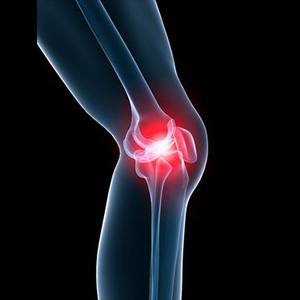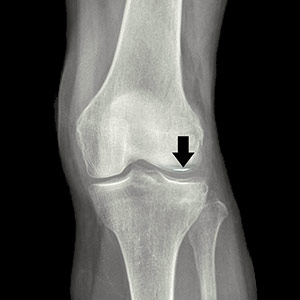- Anatomy
- Conditions
- Procedures
Knee Arthritis

The joint surface is covered by a smooth articular surface that allows pain-free movement in the joint. Arthritis is a general term covering numerous conditions where the joint surface or cartilage wears out. This surface can wear out for several reasons; often the definite cause is not known. Arthritis often affects the knee joint.
Knee Pain

Knee pain is a common condition affecting individuals of various age groups. It not only affects movement but also impacts your quality of life. An injury or disease of the knee joint or any structure surrounding the knee can result in knee pain. A precise diagnosis of the underlying cause is important to develop an appropriate treatment plan.
Anterior Knee Pain

Anterior knee pain is characterized by chronic pain over the front and center of the knee joint. It is common in athletes, active adolescents (especially girls) and overweight individuals. Anterior knee pain refers to various conditions, which include runner's knee or patellar tendinitis, and chondromalacia of the patella.
Chondromalacia Patella

Chondromalacia patella is a common condition characterized by softening, weakening and damage of the cartilage. The condition is most often seen in young athletes and older adults who have arthritis of the knee. It especially occurs in women.
Patellofemoral Arthritis

Patellofemoral arthritis is an inflammatory condition characterized by loss of the smooth cartilage between the kneecap (patella) and the underlying femoral (thigh) bone in the knee joint. When the articular cartilage wears out, the underlying bones rub against each other, causing pain, swelling, stiffness, and restricted movement.
Fractures of the Patella

The patella or kneecap is a small bone present in the front of your knee where the thigh bone meets the shinbone. It provides protection to your knee and attachment to muscles in the front of the thigh. An injury to the knee can result in a break or fracture of the patella.
Patellar Tendonitis

Patellar tendonitis, also known as "jumper's knee", is an inflammation of the patellar tendon that connects your kneecap (patella) to your shinbone. This tendon helps in extension of the lower leg.
Patellar Tendon Rupture

The patellar tendon works together with the quadriceps muscle and the quadriceps tendon to allow your knee to straighten out. Patella tendon rupture is the rupture of the tendon that connects the patella (kneecap) to the top portion of the tibia (shinbone).
Kneecap Bursitis

A bursa is a small fluid-filled sac found between soft tissues and bones. It lubricates and acts as a cushion to decrease friction between bones when they move. Bursitis refers to the inflammation and swelling of the bursa. Inflammation of the bursa in front of the kneecap (patella) is known as kneecap bursitis or prepatellar bursitis.
Quadriceps Tendon Rupture

The quadriceps can rupture after a fall, direct blow to the leg and when you land on your leg awkwardly from a jump. Quadriceps tendon rupture most commonly occurs in middle-aged people who participate in sports that involve jumping and running.
Articular Cartilage Injury (Knee)

Articular or hyaline cartilage is the tissue lining the surface of the two bones in the knee joint. Cartilage helps the bones move smoothly against each other and can withstand the weight of the body during activities such as running and jumping. Articular cartilage does not have a direct blood supply to it so has little capacity to repair itself.
Meniscal Tears

A meniscal tear is a common knee injury in athletes, especially those involved in contact sports. A sudden bend or twist in your knee causes the meniscus to tear. Elderly people are more prone to degenerative meniscal tears as the cartilage wears out and weakens with age.
Degenerative Meniscal Tears

Meniscal tears are one of the most common injuries to the knee joint. Based on their presentation, meniscal tears are classified as traumatic or non-traumatic (degenerative). Traumatic tears usually occur in younger, active individuals (<40 years) and are caused by an acute traumatic injury, most often while playing sports.
Knee Angular Deformities

Angular deformities of the knee are variations in the normal growth pattern during early childhood and are common during childhood. A perfectly aligned knee has its load-bearing axis on an imaginary line that runs through the hip, knee, and ankle.
Tibial Plateau Fracture

A tibial plateau fracture is a crack or break on the top surface of the tibia or shinbone in the knee joint. The fracture most often occurs following a high-intensity trauma or injury from the impaction of the femoral condyles over the tibial plateau. Fractures of the tibial plateau are serious injuries that are more commonly seen in athletes involved in high-impact sports such as basketball, rugby, and football and can put athletes out of action for a long period of time.
Insufficiency Fracture of the Knee

Insufficiency fracture of the knee, also referred to as subchondral insufficiency fracture of the knee (SIFK), is a type of stress fracture that occurs when excessive and repetitive stress is applied to the femoral condyles or tibial plateau of the knee.
Knee Joint Bursa Infection

Knee joint bursa infection, also known as septic knee bursitis, is a condition characterized by inflammation of the small fluid-filled sacs (bursa) near the knee joint due to an infection caused by bacteria or other microorganisms. This occurs either on the kneecap, below the joint, or the inner side of the knee.
Knee Sprain

Knee sprain is a common injury that occurs from overstretching of the ligaments that support the knee joint. A knee sprain occurs when the knee ligaments are twisted or turned beyond its normal range, causing the ligaments to tear.












